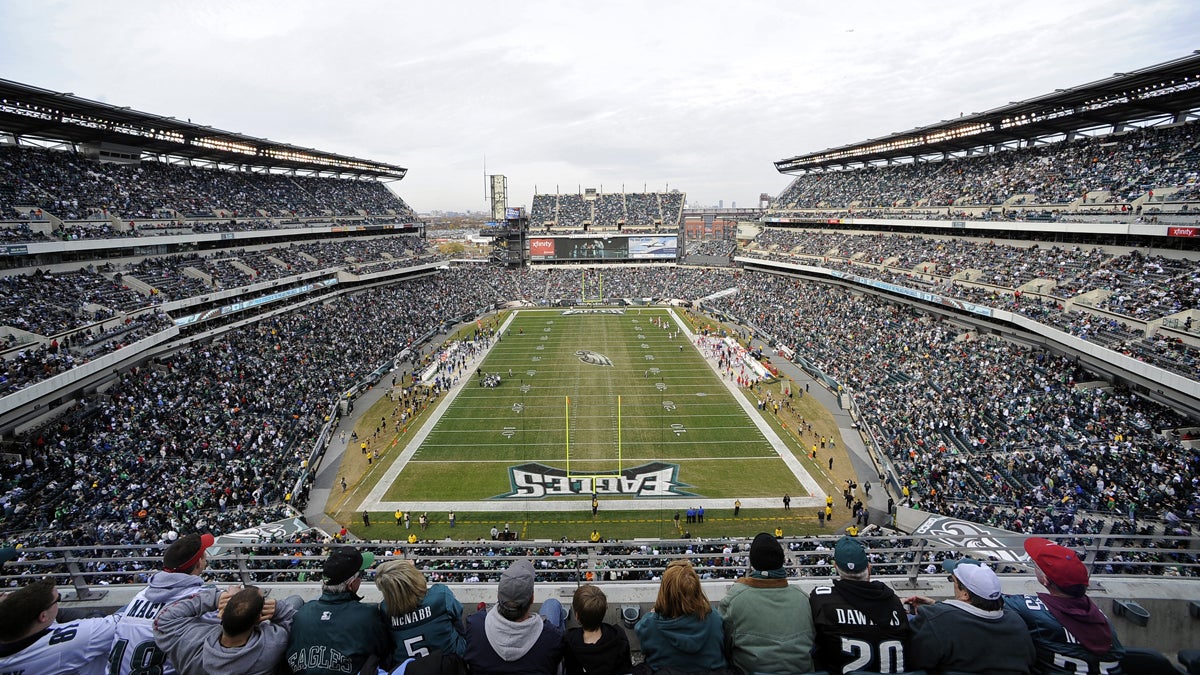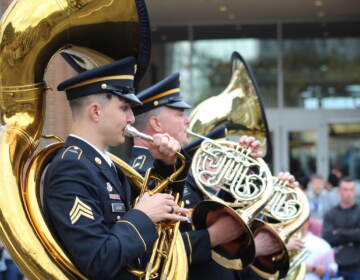$765 million settlement in NFL concussion lawsuits

Philadelphia's Lincoln Financial Field is shown during a 2011 NFL football game between the Eagles and the Arizona Cardinals. (AP Photo/Michael Perez, file)
The NFL has reached a settlement with thousands of former players, who accused the league of ignoring evidence about the dangers of head injuries. The agreement averts what could have been a very lengthy legal battle.
The NFL will pay $765 million to former players, for medical care, injury compensation, and research on head injuries. In doing so, the league does not admit it was at fault. More than 4,000 former players were suing the NFL.
Andrew Brandt, director of Vilanova’s sports law program and an analyst with ESPN, attended a federal court hearing in the case this spring in Philadelphia. “The NFL was very clear this was a matter not for litigation, not for the courts, but to be handled through an arbitration process,” Brandt said. “The players were clear that the NFL had glorified violence, had concealed information, was negligent.”
The judge had ordered mediation to resolve a case that otherwise could take years. Brandt says he is shocked the two sides reached a deal.
“There is sort of this rush to declare the NFL the big winners — a $9.5 billion company, with less than 10 percent going to a settlement on their major threat to the future,” he said.
Brandt says these retired players — many of whom are sick — may not have all that much time and resources to go through court or arbitration and could face challenges in proving the NFL was responsible for their health problems.
“My reaction was a big wow,” said Marc Edelman, associate professor of law at Baruch College’s Zicklin School of Business. “I think it’s a statement by the plaintiff’s lawyers that they truly wanted to help the plaintiffs immediately, by giving them the money they need to improve their life. And it’s a real statement from the NFL that they want to be sure it gets handled in a professional way and that the league can move forward in its business.
Edelman says while this phase of the lawsuit appears headed for resolution, concussions are still a major point of contention in sports, pointing to lawsuits still in progress regarding the NHL and NCAA.
Players can opt out of the settlement. The mediator, a former judge, said in a statement it would now be difficult for current or future players to file similar suits.
DV.load(“//www.documentcloud.org/documents/781879-principal-terms-of-nfl-litigation-settlement.js”, {
width: 600,
height: 800,
sidebar: false,
text: false,
page: 2,
container: “#DV-viewer-781879-principal-terms-of-nfl-litigation-settlement”
});
Principal Terms of NFL Litigation Settlement (PDF)
Principal Terms of NFL Litigation Settlement (Text)
High-profile plaintiffs
The plaintiffs include at least 10 members of the Pro Football Hall of Fame, including former Dallas Cowboys running back Tony Dorsett. They also include Super Bowl-winning quarterback Jim McMahon and the family of Pro Bowl linebacker Junior Seau, who committed suicide last year.
Many former players with neurological conditions believe their problems stem from on-field concussions. The lawsuits accused the league of hiding known risks of concussions for decades to return players to games and protect its image.
The NFL has denied any wrongdoing and has insisted that safety has always been a top priority.
Senior U.S. District Judge Anita Brody in Philadelphia announced the proposed settlement Thursday after months of court-ordered mediation. She still must approve it at a later date.
The settlement likely means the NFL won’t have to disclose internal files about what it knew, when, about concussion-linked brain problems. Lawyers had been eager to learn, for instance, about the workings of the league’s Mild Traumatic Brain Injury Committee, which was led for more than a decade by a rheumatologist.
In court arguments in April, NFL lawyer Paul Clement asked Brody to dismiss the lawsuits and send them to arbitration under terms of the players’ contract. He said that individual teams bear the chief responsibility for health and safety under the collective bargaining agreement, along with the players’ union and the players themselves.
Players lawyer David Frederick accused the league of concealing studies linking concussions to neurological problems for decades.
Brody had initially planned to rule in July, but then delayed her ruling and ordered the two sides to meet to decide which plaintiffs, if any, had the right to sue. She also issued a gag order, so it has been unclear in recent weeks whether any progress was being made.
The lawyers were due to report back to her Tuesday, but Brody instead announced in court files Thursday that the case had settled.
Concussions a major theme in the NFL
In recent years, a string of former NFL players and other concussed athletes have been diagnosed after their deaths with chronic traumatic encephalopathy, or CTE. Those ex-players included Seau and lead plaintiff Ray Easterling, who filed the first suit in Philadelphia in August 2011 but later committed suicide.
About one-third of the league’s 12,000 former players have joined the litigation since 2011. They include a few hundred “gap” players, who played during years when there was no labor contract in place, and were therefore considered likely to win the right to sue.
The timing of the settlement allowed the NFL to drop the issue from the national conversation before the start of the new season.
All 32 clubs were scheduled to play their final exhibition games Thursday night, in preparation for the start of the regular season next week. The first real game is next Thursday, with the reigning Super Bowl champion Baltimore Ravens playing at the Denver Broncos.
Concussions — and the former players’ lawsuits — had become a main theme of recent NFL seasons, with players, coaches and league officials all forced to address the topic repeatedly, especially as new plaintiffs came forward on nearly a weekly basis. It was the sort of public relations distraction the league has become skilled at avoiding — and the easiest way to set this topic aside, of course, was to have the court cases resolved.
WHYY is your source for fact-based, in-depth journalism and information. As a nonprofit organization, we rely on financial support from readers like you. Please give today.




